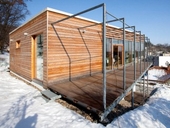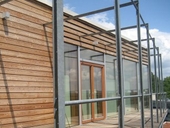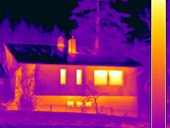This method has been known in Germany since 1930. Since then it has through many changes and technological advances. The use of hot air units continued to be developed and, after 1950, heat oil started to be used as fuel, and it is still used to this day. However, the use of hot air to eradicate wood-destroying insects makes sense only when there is an active infestation. A straightforward evidence of active infestation are the occurrence of larvae or beetles when carving wooden profiles. Other evidences can also be crunching sounds, fresh sawdust or paths of lighter colour. However, even if none of this has been detected, it doesn't necessary mean that the wood isn't infested. It should also be noticed that falling sawdust can also occur even after a successful “thermo sanitation”.
Archiv článků od 28.9.2009 do 8.11.2010
I am very often asked what issues are still being addressed at the seminars on passive houses, because they have all been already resolved and these buildings are pretty common abroad. The truth is that in other countries the construction of low energy buildings started in the 1990's. However, their ecological, technical and energetic aspects are still evolving. The building structure itself is improving, as well as the insulation systems, heating, ventilation and new building materials and technologies are becoming more sophisticated. It has all gradually come to houses that consume almost no energy. Let's have a look at some of the aspects of the developments.
Sophisticated heating solutions lead to the fact that if at any given stage of the thermal insulation a TRV is properly fit and adjusted and, at the same time, a sophisticated substation solution is installed, one that will “know” how to prepare and maintain the required parameters, mainly during the heating season, then there will be nothing to renovate or solve during the lifespan of the heating station, other than adjusting the temperature and hydraulic parameters correctly.
The attenuation of sound wave with bends is mostly used in the design of noise walls, curtains and barriers along ways with intensive traffic (roads, rail and tram). Noise reduction from stationary sources with curtains is less common because it is always better to place the noisy device in the machine hall. This is then ventilated through a system with big enough dimensions so as to absorb sound, which then blocks the source of sound and the fan noise. Let's look at some specific installations seen in this context as well as calculations of the sound attenuation bend.
The problematic of energy savings should not be limited only to thermal insulation and occasional use of alternative energy sources. The energy used not only for heating, but also for ventilation and air conditioning. Significantly affect the consumption requirements, deciding which areas will be heated and at what temperatures. Energy is needed to produce construction materials, their transportation and eventual waste handling. The lifespan of the proposed construction and the complexity of its liquidation should be one of the essential criteria when deciding on contemplated modifications. It is necessary to consider buildings as architectural heritage.
The Czech Council for Green Buildings and the British Council, in addition to their other activities, are organising the so-called Biohouse seminars, which include visits to selected buildings. We have attended one of them and we had a look at three interesting buildings in the surroundings of Prague. The first stop of the mini-bus was Pikovice, where an untraditional low energy wooden house, with a gazebo is located. We were expected by the investor, the architect and the projector. The second building, which had almost passive standards, we shown to us by the investor, who personally devised to ideological concept of the house in the outskirts of the village Tehov u Říčan. The third building, located in the garden of the former parish house in Sluštice u Prahy, was shown to us by a representative of the investor, who took us to the world of children. It is a beautiful wooden building projected as a pre-school in a Waldorf style.
Windows have always been considered a construction surface that had to allow in enough day light and at the same time, protect the interior from wind and rain. Windows protected the house from the outside world, while at the same time enabling communication. The technical capabilities, along with the climatic and economic conditions of different historical periods shaped the appearance of the windows, which also helped create the different architectural styles. The proportions, materials and the segmentation of windows on the façades were also influenced by geographical location, cultural influences and regional aesthetics. The height and width relationships in windows, and their relationship with the total area of the walls, the appropriate width of the interior posts and other similar parameters where basics of the compositional works. Much attention was paid to the fine details. Window openings were framed with various decorative ornaments. The windows of a passive house are among the most complicated structures of the building.
Do you know how to choose a supplier and installers for windows? The article answers to important questions regarding the choice of windows, their frames, glazing, ironwork, sills and accessories such as shadings, etc. The author speaks from personal experiences with suppliers, manufacturers and technical supervisors. The article wants to help people buy windows with the best price/quality ration and ensure their long term satisfaction.
The basic importance of the use of inert gas in the space between insulating glasses is its lower thermal conductivity, i.e. the ability to provide greater resistance to heat transfer. Simply put, the inert gasses (argon, krypton, xenon) have this property because in principle their molecules do not create in structure among themselves or with particles from other gasses and strictly occur in monomolecular arrangements, which significantly reduces the transfer of kinetic energy between the molecules, which is the driving force of heat. The paper analyses the variabilities of the heat transfer coefficient of Ug glasses depending on changes in the concentration of inert gases and the width of the space between insulating glasses.
Windows, as fillings of peripheral orifices in the structure of buildings, are a construction product, which either must be tested or verified for their compliance with the various Czech regulations and standards. One of the most important criteria that window structures must meet is the one prescribed by ČSN 730540-2 Thermal Protection of Buildings from April 2007 The compliance of the inner surface temperature factor with the standard ČSN 730540-2 must be verified separately for each orifice filling structure. So far, there are no universally applicable rules that determine which edge of glazing units can be applied to with structure. The area of the glazing joints is among the riskiest parts of the whole structure, and that is why two basic design rules were derived in order to provide an increase the internal surface temperature in that area.
The aim of the diurnal lightning proposal is to rectify rooms' access to sunlight, which is dispersed in the atmosphere, and to rectify the visual comfort of the users of the interior during daylight hours; i.e. the appropriate lightning conditions for visual work carried out in the interior. The specifications of diurnal lightning are formulated in IEC-730580-1 to 4. These specifications are binding because the relevant articles mentioned in the standards are determined as binding laws and decrees 268/2009 on the technical requirements for construction, 258/2000 on Public Health, 410/2005 on hygiene requirements for educational facilities and the education of children, Government Decree 361/2007 on sanitary conditions at work. In situations where controls of calculations of measurements are not possible or too difficult, it is then necessary to maximise the transparency of computational procedures. In particular, it is necessary to include all the variables that enter into the calculation (factors of brightness shading barriers, factors of transmission and reflection of light). When assessing the accuracy of the calculations, it is also necessary to require detailed descriptions of the computational models used in determining the individual components of the diurnal lightning factors.
The following contributions, which deal with this problematic, consider the impact of high heat resistance of the walling on the thermal comfort and the design of heating ventilations systems, which are still perceived, as it is the case in buildings with classical walling, therefore, to have lower thermal resistance. For instructions to formulate the effect of walling on the thermal comfort and technical equipment, a general comparison of both the following cases is made, which is simply called building with high thermal resistance of external walls for a low-energy house, and a building with classical walling parameters (e.g. housing estate from the past) as a standard house. The articles are not of exact technical nature and deal with regularly updated dependencies and sometimes refer to previously applicable legal provisions.
A commonly used procedure of calculation by (2) assigns to a transparent structure the same output value of a correction factor and total throughput screening of solar radiation on a monthly basis for the whole year. The question is to what extent this simplification is appropriate for low- energy and passive houses. The paper deals with a comparison between a nominal and detailed methods of calculating passive solar gains in situations of normal shading with normal structures and surrounding barriers, and their subsequent impact on the need for heating. The calculations have showed that even in extreme cases based on the presented examples (windows only on the Southern porch, windows just to the west with grills) for buildings with heat requirements of 15-20 kWh/m2.year, the precision of the calculations of passive solar gains are affected resulting on a higher demand for heating of up to 10%.
The author draws attention to the deterioration of the quality of indoor environments in flats where the original windows have been replaced by modern, tight windows, which although improve the flat's energy balance, they also limit the possibilities for ventilation. Moisture that has not been ventilated accumulates in the flat, which leads to mould growth, and in the case of gas appliances, there are also exhaust gases, which are are toxic substances that lead the health problems, intoxications and even death. In the Czech legislation there aren't sufficient basis for an unambiguous determination of the requirements for the quality of the indoor environment of flats, including the requirements for their security, i.e. ventilation. The information can be found in selected European Standards, the author cites ČSN EN 15251.
We can observe in the Czech press a significantly higher frequency of expressions suchs as passive house or energy-efficient construction, specially in connection with the subsidy program “Zelená Úsporám”. However, the reality is that the number of passive houses built is very low, moreover, in some of the so called passive houses there can certainly be doubts about their actual properties.
The important factor during the process of the preparation and the realization of the buildings is the knowledge of the legal regulations that solve the safety at construction. The solving of safety begins already during the preparation of the building plan. The investor should find out whether the planned construction is a kind of constructions for that a coordinator for safety at construction must be established. It must be distinguish to which extend and for which constructions the legal regulations refer and wheather they also refer to houses.
Overview of the contents and recommendations to the appendix in a purchase contract and contract for work. The issue of windows and balconies – windows and doors - is very extensive and contains many requirements. This resulted in the manual “Technical conditions for the purchase and installation of windows”, which seeks a simple, yet all-encompassing for to describe the requirements for the windows, so less sophisticated techniques could apply to suppliers. The article is the introductory text of this guide, which is available for download. This is purely a technical manual that tries to cover all the usual cases of windows, requiring them, their evaluation, classification and their density. The manual does not replace or otherwise alter the forthcoming standard dealing with the requirements for windows and doors in buildings. The manual is completely independent and does not know about what is included the upcoming standard.
The examination method Blower-Door test (fan pressurisation method) is used for measurements of air permeability of buildings and is also used for leakage detection. The result of the measurement is air leakage rate at the pressure differential across the building envelope of 50 Pa. The article points out leaky details which often appear at constructions. The article shows the possibility of using infrared camera and anemometer for leakage detection.
New Czech technical standard ČSN 73 0810 Fire protection of buildings - General requirements was issued in April 2009. This standard replaced the standard of the same title issued in June 2005. New standard has expanded or changed some of the paragraphs. Important changes are defined in the article.
zpět na aktuální články


